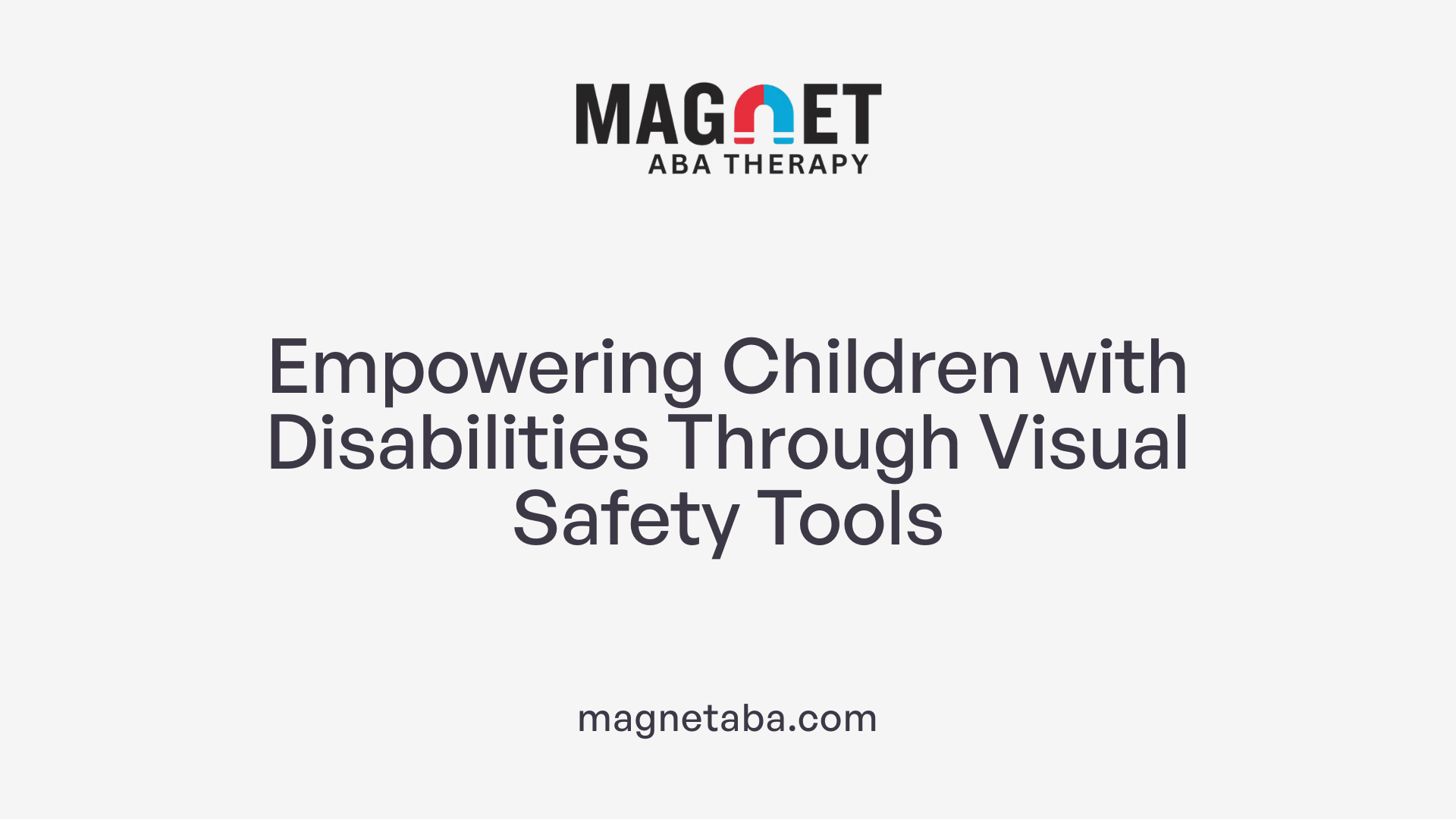Understanding the Unique Challenges and Opportunities
In today’s digital landscape, teaching children with autism and other neurodiverse conditions about online safety and boundaries is more crucial than ever. While the internet offers incredible opportunities for learning and social connection, it also presents unique risks that require tailored educational strategies. Applied Behavior Analysis (ABA) provides a structured, effective framework for guiding children to develop safe online behaviors and respect personal boundaries, integrating visual tools, behavioral techniques, and collaborative involvement by families and educators.
The Role of Visual Tools in Teaching Digital Safety
How do visual aids assist children with autism in understanding online safety?
Visual aids like social stories, charts, and visual schedules serve as powerful tools to teach children with autism about online safety. These concrete, easily understandable visuals help them grasp complex concepts like cyberbullying, inappropriate content, and recognizing strangers. For example, a social story might depict step-by-step actions to take if they encounter unkind messages, reinforcing safe behaviors.
Visual schedules can outline daily routines that include designated internet use times, fostering a structured approach to screen time and digital habits. Charts displaying acceptable versus unacceptable online behaviors enable children to see clear boundaries, supporting better decision-making.
How do behavioral techniques complement visual tools in teaching safety?
Behavioral techniques, such as positive reinforcement, are integrated with visual tools to encourage consistent safe online behaviors. Strategies like 'Say—Show—Do—Check In' involve practicing responses to online situations, reinforcing learning through repetition and rewards.
Applied Behavior Analysis (ABA) therapy often uses these combined approaches to help children internalize safety rules—like not sharing personal information or clicking unknown links—and apply them confidently in real-world scenarios.
What steps can parents and caregivers take to support learning about online safety?
Parents and caregivers can utilize visual aids to reinforce safety rules at home. Creating visual guides about online boundaries, explaining who are safe adults and how to handle strange messages, helps children understand expected behaviors. Using visual cues on devices, such as icons for reporting or blocking, empowers children to take proactive steps.
Open communication complemented by visual teaching supports children in translating rules into everyday online interactions. Combining these tools with consistent practice ensures children are better equipped to navigate digital spaces safely.
| Visual Tools | Purpose | Behavioral Techniques | Application Example |
|---|---|---|---|
| Social Stories | Explain safety scenarios | Positive Reinforcement | Reward for practicing 'ask permission' before online activity |
| Charts & Visual Schedules | Establish routines & boundaries | Structured Practice | Daily visual schedule for internet use |
| Visual Cues & Icons | Recognize risks & actions | Role-Playing & Repetition | Buttons for report/block functions |
By using visual aids alongside behavioral strategies, we can better support children with autism in understanding and practicing safe online behaviors, helping them develop independence and confidence in digital environments.
Integrating ABA Principles into Online Safety Education

How can ABA principles be incorporated into educating children and adolescents about responsible internet use?
Applied Behavior Analysis (ABA) offers effective strategies for teaching children about safe online behaviors. Using positive reinforcement, parents and educators can reward responsible actions such as privacy protection or polite communication, encouraging children to repeat these behaviors.
Functional Behavioral Assessments (FBA) play a crucial role by helping identify what motivates certain online behaviors. These assessments allow for tailored interventions that address specific needs or challenges, such as impulsivity or difficulty recognizing risky situations.
Teaching digital citizenship involves modeling appropriate conduct, role-playing scenarios, and using social stories. For example, demonstrating how to manage personal information securely or how to respond to strangers online helps children understand boundaries and safety.
Furthermore, ongoing reinforcement helps solidify responsible habits. Consistent praise, rewards, or privileges after positive online behavior encourages children to develop lifelong safe internet practices.
Both teachers and parents can use practical tools like parental controls, curated curriculum activities, and real-life scenarios to instill good digital habits. Collaboration between caregivers and educators ensures that lessons are age-appropriate and adaptable.
By regularly assessing progress, providing clear guidance, and engaging children in discussions about online safety, adults can foster a strong foundation of responsible internet use. This integrated approach equips youth with the skills needed to navigate the digital world confidently and securely.
Strategic ABA Approaches to Digital Safety and Boundaries

What are effective strategies for teaching children about digital safety and boundaries using ABA principles?
Applied Behavior Analysis (ABA) offers practical tools to teach children about digital safety and respecting boundaries. Central to this approach is the use of visual supports, such as social stories and visual schedules, which help children understand expected behaviors online and offline.
Role-playing and modeling are also essential. For instance, parents and educators can simulate online situations, demonstrating safe interactions, privacy settings, and asking permission before sharing personal information. These activities promote understanding and retention.
Incorporating rhythm, rhyme, and repetition through songs and scripts makes safety lessons more engaging and memorable. Using multi-modal methods—visual, auditory, and physical—reinforces the learning process.
Reinforcement is vital. Rewarding children with praise or tangible incentives when they demonstrate safe online behaviors encourages ongoing practice and generalization across varied social settings.
Teaching social-emotional skills, such as assertiveness and problem-solving, equips children to handle risky situations independently. These skills empower them to recognize red flags, refuse inappropriate requests, and seek adult help.
Furthermore, establishing clear routines with visual schedules, including designated screen-free times, helps balance technology use while emphasizing safety principles. Setting boundaries through consistent routines fosters responsible digital citizenship.
In summary, strategies like visual aids, role-playing, rhythm and rhyme, positive reinforcement, and boundary-setting form an effective framework in ABA to teach children safe online behaviors and respect for boundaries, supporting their independence and well-being in digital spaces.
Teaching Privacy and Safe Online Behavior for Children with Disabilities

How can visual supports and social stories be used to establish safety practices?
Visual supports and social stories are effective tools for helping children with disabilities understand safe online behaviors. Visual supports, like colorful diagrams or nested circles, illustrate who is safe to interact with online versus who to avoid. Social stories describe acceptable and unacceptable online interactions using simple language and scenarios, making abstract concepts concrete. These tools help children internalize safety routines, such as not sharing personal info or recognizing suspicious messages.
How can children recognize online risks like scams and cyberbullying?
Teaching children to identify red flags such as suspicious messages, requests for personal details, or unkind comments is essential. For children with autism, specific behaviors—like ignoring strange links or refusing to open unknown messages—can be reinforced through practicing scenarios. Recognizing signs of cyberbullying or scams empowers children to seek help and alert an adult. Building social awareness helps them navigate online spaces confidently.
What are best practices for monitoring online activity and using parental controls?
Parents should establish clear digital boundaries and monitor online usage regularly. Using tools like parental controls—such as Mobicip—helps filter inappropriate content, set time limits, and block suspicious sites. Active supervision involves checking browsing history and having open conversations about online experiences. Encouraging offline activities balances screen time and reduces online risks.
How should children be taught to keep personal information private?
Children need explicit instruction on what details are safe to share online, such as their first name or favorite hobby—but not sensitive info like addresses or passwords. Visual aids can clarify what is appropriate to reveal. Parents should support children in managing privacy settings on social media and emphasize that they should ask for help if unsure about sharing information. Teaching setting boundaries around personal details fosters independence and safety.
Implementing ABA Interventions in Digital Safety Education
How can educators and caregivers implement ABA-based interventions to teach digital safety and boundary setting?
Applied Behavior Analysis (ABA) offers practical strategies for teaching children, especially those with autism or other neurodiverse conditions, to navigate the digital world safely.
One effective approach involves structured teaching sessions that utilize errorless learning, prompting, and reinforcement. These methods ensure children learn correct online behaviors without confusion or frustration. For example, caregivers can provide cues and immediate positive feedback when a child practices safe online habits, such as recognizing suspicious messages.
Visual supports are also integral to ABA strategies. Tools like social stories, visual schedules, and role-playing scenarios help children understand various online risks — from cyberbullying to scams and inappropriate content. Role-playing exercises prepare children to respond appropriately if they encounter challenging situations online.
Monitoring and guiding online activities is another critical component. Adult supervision, combined with shared browsing sessions, helps reinforce boundaries. Encouraging children to seek help when faced with uncomfortable content fosters independence and safety.
Collaboration with trained ABA professionals ensures interventions are tailored to each child's unique needs. These specialists develop personalized strategies that incorporate family routines and individual learning styles, promoting effective skill acquisition.
By integrating these methods, educators and caregivers can create a safer online environment, fostering children's confidence and autonomy while minimizing risks. Ongoing supervision and consistent reinforcement help solidify these safety habits.
| Strategies | Tools Used | Purpose |
|---|---|---|
| Structured teaching sessions | Errorless teaching, prompts | Teach safe online behaviors effectively |
| Visual supports and role-playing | Social stories, role-playing | Help children understand and practice boundaries |
| Monitoring and guiding online | Supervised browsing, feedback | Reinforce appropriate online conduct |
| Collaboration with ABA professionals | Personalized programs | Ensure interventions meet individual needs |
Utilizing ABA methods in digital safety education helps children develop crucial boundary-setting skills, ensuring they can explore online spaces securely and independently.
Parental Role and Family Strategies

How can parents and caregivers facilitate effective teaching of digital safety and boundaries using ABA principles?
Parents and caregivers play a vital role in guiding children, especially those with neurodiverse conditions like autism, in understanding and respecting boundaries online. One effective approach involves modeling respectful and empathetic behavior in everyday interactions. Children often learn by observing their parents, so demonstrating kindness, patience, and honesty sets a positive example.
Engaging children in open discussions about their online experiences helps build trust and understanding. Asking questions about what they see or hear online, and discussing potential red flags such as sharing personal information or encountering strangers, prepares children to recognize risks.
Implementing family tech agreements is another valuable strategy. These agreements involve children in setting rules around screen time, types of content they can access, and appropriate online behaviors. This participatory process fosters decision-making skills and a sense of ownership over their digital activity.
Using tools like parental controls and filtering software further enforces safety boundaries. These tools can restrict access to inappropriate content, set time limits, and enable parents to monitor online activity effectively.
Open communication complemented by these tools creates a nurturing environment where children feel supported and protected. When combined with consistent modeling and clear rules, these family strategies align with behavioral principles to teach children how to navigate the online world responsibly.
Fostering open communication about online experiences
Creating a safe space for children to share their online encounters encourages honesty and readiness to discuss uncomfortable situations.
Using parental controls and educational tools
Resources like filtering software and online safety curricula, provided by organizations such as IKeepSafe and ConnectSafely, guide both parents and children in practicing safe internet use. These tools not only restrict harmful content but also educate children on digital boundaries and respectful behavior.
| Strategy | Purpose | Implementation Tips | Benefits |
|---|---|---|---|
| Model respectful behavior | Sets behavioral examples | Demonstrate kindness and patience in daily interactions | Clients better understand social cues and boundaries |
| Family tech agreements | Clarifies rules and expectations | Involve children in creating rules for online activity | Promotes responsibility and decision-making |
| Open communication | Builds trust and safety | Regularly discuss online experiences and feelings | Children feel comfortable sharing concerns |
| Use of parental controls | Ensures safe browsing | Install and configure filtering tools and report features | Protects against harmful content and cyber threats |
By adopting these approaches, parents can enhance their child's ability to stay safe online, respecting boundaries and developing compassionate digital habits.
Building a Collaborative Approach for Digital Safety

How can partnerships among parents, educators, and ABA professionals improve digital safety for children?
Creating a strong network of collaboration is essential for effective digital safety education. Parents, teachers, and Applied Behavior Analysis (ABA) professionals each bring valuable insights about a child's development and online behaviors. Working together enables tailored strategies that address specific needs, especially for neurodiverse children. This teamwork can include shared monitoring, consistent messaging, and coordinated interventions, helping children better understand boundaries and navigate the online world safely.
What educational resources and curricula are available for promoting digital safety?
Various programs and tools are designed to teach children about online safety. Digital platforms like tablets, phones, and YouTube are used in puberty education for children with intellectual disabilities and autism spectrum disorder. Resources include interactive online games, structured curricula, and safety pledge programs that encourage good habits. Parental involvement is encouraged through family tech agreements that set clear boundaries requiring children to participate in decisions about their internet use.
How does promoting social understanding and acceptance of differences play a role?
Fostering acceptance begins with teaching children to respect boundaries and empathize with others’ feelings. Strategies such as discussing scenarios, modeling respectful behavior, and encouraging interactions with diverse groups help develop social skills and reduce prejudice. For children with autism, visual aids like nested circles show appropriate interactions with family, community helpers, and strangers, clarifying safe boundaries and expected behaviors.
Why is early intervention and ongoing reinforcement important?
Early teaching of safety and boundaries helps children grasp expected behaviors before risky online or social situations arise. Continuous reinforcement through real-time responses to problem behaviors, along with ongoing discussions about safety, supports better learning and adapts to a child's evolving needs. Regular communication among caregivers, educators, and therapists ensures that safety strategies are reinforced consistently, fostering a safer digital environment for all children.
Fostering Confidence and Safety in the Digital World
Teaching children with autism about online safety and boundaries through ABA is a comprehensive effort that integrates visual supports, behavioral techniques, and collaborative strategies. By tailoring interventions to each child's needs, reinforcing positive behaviors, and involving families actively, we can create a safe digital environment that encourages responsible exploration and social understanding. As technology continues to evolve, ongoing education and proactive planning are essential to equip neurodiverse children with the skills to navigate the digital world confidently, safely, and respectfully.
References
- Teaching Kids About Boundaries
- How to Keep Your Neurodiverse Child Safe Online
- Cybersafety
- Be Internet Awesome - A Program to Teach Kids Online Safety
- Teaching Stranger Safety to Kids with Autism
- Autism Services Guide: Helping Your Child Safely Navigate ...
- Internet Safety Rules You Need To Teach A Child With ...
- Cyber Safety Resource Collection
- Autism Online Safety: 6 Actionable Steps For Digital ...












